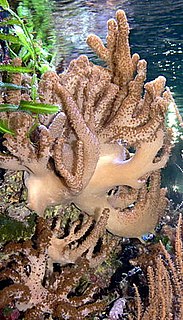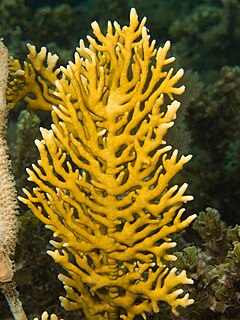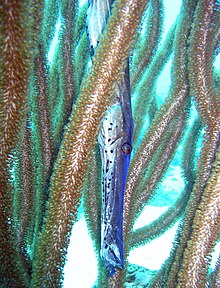
Anthozoa is a class of marine invertebrates which includes the sea anemones, stony corals and soft corals. Adult anthozoans are almost all attached to the seabed, while their larvae can disperse as part of the plankton. The basic unit of the adult is the polyp; this consists of a cylindrical column topped by a disc with a central mouth surrounded by tentacles. Sea anemones are mostly solitary, but the majority of corals are colonial, being formed by the budding of new polyps from an original, founding individual. Colonies are strengthened by calcium carbonate and other materials and take various massive, plate-like, bushy or leafy forms.

The giant basket star, Astrophyton muricatum, is an echinoderm found in shallow parts of the tropical western Atlantic and throughout the Caribbean Sea and the Gulf of Mexico. It is the only species in the genus Astrophyton. During the day, it curls up into a tight ball shape to protect itself from predators. At night, it climbs to an elevated point to feed by extending its intricately branched feeding arms in a bowl-like shape in order to snare passing plankton and other organisms from the current.

Isis hippuris, also known as sea bamboo, is a species of bamboo coral found in the Western Pacific Ocean, commonly near the coasts of Indonesia. I. hippuris reproduce asexually, and is abundant throughout its habitats in Indonesia. For centuries, I. hippuris has been identified by its bamboo or bony-looking structure. Additionally, it is notable for producing Hippuristanol, a molecule that could potentially have anti-cancer applications. While no actual conclusion regarding Hippuristanol in I. hippuris has been published, scientists and marine biologists continue to study how the molecule could be used in cancer research and recovery. Although only found in the Western Pacific Ocean, I. hippurisis highly sought after across the globe, and is seen as a symbol of beauty.

Alcyonacea, or soft corals, are an order of corals. In addition to the fleshy soft corals, the order Alcyonacea now contains all species previously known as "gorgonian corals", that produce a more or less hard skeleton, though quite different from "true" corals (Scleractinia). These can be found in suborders Holaxonia, Scleraxonia, and Stolonifera. They are sessile colonial cnidarians that are found throughout the oceans of the world, especially in the deep sea, polar waters, tropics and subtropics. Common names for subsets of this order are sea fans and sea whips; others are similar to the sea pens of related order Pennatulacea. Individual tiny polyps form colonies that are normally erect, flattened, branching, and reminiscent of a fan. Others may be whiplike, bushy, or even encrusting. A colony can be several feet high and across, but only a few inches thick. They may be brightly coloured, often purple, red, or yellow. Photosynthetic gorgonians can be successfully kept in captive aquaria.

Fire corals (Millepora) are a genus of colonial marine organisms that exhibit physical characteristics similar to that of coral. The name coral is somewhat misleading, as fire corals are not true corals but are instead more closely related to Hydra and other hydrozoans, making them hydrocorals. They make up the only genus in the monotypic family Milleporidae.

Duncanopsammia is a monotypic genus of stony corals. It is represented by the single species, Duncanopsammia axifuga, commonly called whisker coral, duncanops coral, or simply duncan coral. Individual polyps are fairly large with round skeletal bases (corallites) 10–14 millimetres (0.39–0.55 in) in diameter and larger central discs from which multiple tentacles radiate; the polyps form a structure branching at irregular intervals to form a large colony.

Blue coral is a species of colonial coral. It is the only octocoral known to produce a massive skeleton. This skeleton is formed of aragonite, similar to that of scleractinia. Individual polyps live in tubes within the skeleton and are connected by a thin layer of tissue over the outside of the skeleton.

The open brain coral is a brightly colored free-living coral species in the family Merulinidae. It is the only species in the monotypic genus Trachyphyllia and can be found throughout the Indo-Pacific.

Millepora alcicornis, or sea ginger, is a species of colonial fire coral with a calcareous skeleton. It is found on shallow water coral reefs in the tropical west Atlantic Ocean. It shows a variety of different morphologies depending on its location. It feeds on plankton and derives part of its energy requirements from microalgae found within its tissues. It is an important member of the reef building community and subject to the same threats as other corals. It can cause painful stings to unwary divers.

Melithaea ochracea is a species of colonial soft coral in the family Melithaeidae, commonly known as knotted fan coral. It grows in tree-like fans on coral reefs in the South China Sea. It is used in the jewellery industry under the name red spongy coral.

Gorgonia flabellum, also known as the Venus fan, Venus sea fan, common sea fan, West Indian sea fan, and purple gorgonian seafan, is a species of sea fan, a sessile colonial soft coral.

Colpophyllia is a genus of stony corals in the family Mussidae. It is monotypic with a single species, Colpophyllia natans, commonly known as boulder brain coral or large-grooved brain coral. It inhabits the slopes and tops of reefs, to a maximum depth of fifty metres. It is characterised by large, domed colonies, which may be up to two metres across, and by the meandering network of ridges and valleys on its surface. The ridges are usually brown with a single groove, and the valleys may be tan, green, or white and are uniform in width, typically 2 centimetres. The polyps only extend their tentacles at night.

Nidaliidae is a family of soft corals in the phylum Cnidaria. Some members of this family are similar in appearance to gorgonians. They are difficult to keep in the reef aquarium because they do not contain symbiotic zooxanthellae and therefore need to be fed on zooplankton. Others, in the genera Agaricoidea, Nidalla and Pieterfaurea, more resemble members of the family Nephtheidae and these are somewhat easier to keep in the aquarium.

Cantherhines macrocerus, commonly known as the whitespotted filefish or American whitespotted filefish, is a marine fish found along the coast of Florida extending southward into the Caribbean. This species is distinct and separate from Cantherhines dumerilii, the similarly named whitespotted filefish which is found in the Indian and Pacific oceans.

Eunicea is a genus of gorgonian-type octocorals in the family Plexauridae. These branched octocorals typically have knobby protuberances from which the polyps protrude. They are often stiffened by purple sclerites and some colonies, in brightly lit back-reef areas are purple, though most colonies are brown or grey. The polyps in some species are large and feathery in appearance. The growth of these corals is rapid and they can be kept in a reef aquarium.
Pseudoplexaura porosa, commonly known as the porous sea rod or the porous false plexaura, is a species of gorgonian-type colonial octocoral in the family Plexauridae. It is native to the Caribbean Sea and the Gulf of Mexico.
Muriceopsis is a genus of gorgonian-type, branching colonial octocorals in the family Plexauridae. They are found on shallow water reefs and are capable of developing sweeper tentacles. The growth of these corals is rapid and they can be kept in a reef aquarium.
Acropora desalwii is a species of acroporid coral that was first described by Dr Carden Wallace in 1994. Found in sheltered, tropical, shallow reefs, mainly on the slopes, this species is generally found at depths below 15 metres, but this can be as low as 30 metres. The species is rated as vulnerable on the IUCN Red List, with a decreasing population, and is affected by disease. It is common and found over a large area, and is listed under CITES Appendix II.
Acropora kimbeensis is a species of acroporid coral that was first described by Dr. Carden Wallace in 1999. Found in marine, tropical, shallow reefs usually at depths of 3 to 12 m, but can occur as low as 15 m (49 ft). It is listed as a vulnerable species on the IUCN Red List, and it is thought to have a decreasing population. It is not common and found over a large area, and is listed on CITES Appendix II.

Gorgonia mariae, commonly known as the wide-mesh sea fan, is a species of sea fan, a sessile colonial soft coral in the family Gorgoniidae. It occurs in the tropical western Atlantic Ocean and the Caribbean Sea at depths down to about 50 m (160 ft).
















